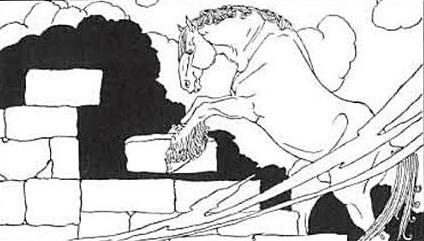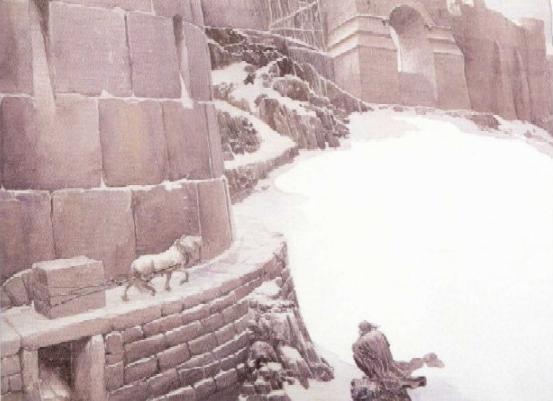
Asgard's Wall
The Milky Way
by Peter Krüger
©2012
The Prose Edda, Gylfaginning 42, tells the story about the construction of the walls of Asgard:
|
Þá mælti Gangleri: "Hverr á þann hest, Sleipni, eða
hvat er frá honum at segja?" Hárr segir: "Eigi kanntu deili
á Sleipni, ok eigi veiztu atburði, af hverju hann kom, en
þat mun þér þykkja frásagnar vert. Þat var snimma í öndverða
byggð goðanna, þá er goðin höfðu sett Miðgarð ok gert
Valhöll, þá kom þar smiðr nökkurr ok bauð at gera þeim borg
á þrim misserum svá góða, at trú ok örugg væri fyrir
bergrisum ok hrímþursum, þótt þeir kæmi inn um Miðgarð, en
hann mælti sér þat til kaups, at hann skyldi eignast Freyju,
ok hafa vildi hann sól ok mána. Þá gengu æsirnir á tal ok
réðu ráðum sínum, ok var þat kaup gert við smiðinn, at hann
skyldi eignast þat, er hann mælti til, ef hann fengi gert
borgina á einum vetri, en inn fyrsta sumarsdag, ef nökkurr
hlutr væri ógerr at borginni, þá skyldi hann af kaupinu.
Skyldi hann af engum manni lið þiggja til verksins. Ok er
þeir sögðu honum þessa kosti, þá beiddist hann, at þeir
skyldu lofa, at hann hefði lið af hesti sínum, er Svaðilfari
hét, en því réð Loki, er þat var til lagt við hann. Hann tók
til inn fyrsta vetrardag at gera borgina, en of nætr dró
hann til grjót á hestinum. En þat þótti ásunum mikit undr,
hversu stór björg sá hestr dró, ok hálfu meira þrekvirki
gerði hestrinn en smiðrinn. En at kaupi þeira váru sterk
vitni ok mörg særi, fyrir því at jötnum þótti ekki tryggt at
vera með ásum griðalaust, ef Þórr kæmi heim, en þá var hann
farinn í austrveg at berja tröll.
|
Then said Gangleri: "Who owns that horse Sleipnir, or
what is to be said of him?" Hárr answered: "Thou hast no
knowledge of Sleipnir's points, and thou knowest not the
circumstances of his begetting; but it will seem to thee worth
the telling. It was early in the first days of the gods'
dwelling here, when the gods had established the Midgard and
made Valhall; there came at that time a certain wright and
offered to build them a citadel in three seasons, so good that
it should be staunch and proof against the Hill-Giants and the
Rime-Giants, though they should come in over Midgard. But he
demanded as wages that he should have possession of Freyja, and
would fain have had the sun and the moon. Then the Æsir held
parley and took counsel together; and a bargain was made with
the wright, that he should have that which he demanded, if he
should succeed in completing the citadel in one winter. On the
first day of summer, if any part of the citadel were left
unfinished, he should lose his reward; and he was to receive
help from no man in the work. When they told him these
conditions, he asked that they would give him leave to have the
help of his stallion, which was called Svadilfari; and Loki
advised it, so that the wright's petition was granted. He set to
work the first day of winter to make the citadel, and by night
he hauled stones with the stallion's aid; and it seemed very
marvellous to the Æsir what great rocks that horse drew, for the
horse did more rough work by half than did the wright. But there
were strong witnesses to their bargain, and many oaths, since it
seemed unsafe to the giant to be among the Æsir without truce,
if Thor should come home. But Thor had then gone into the
eastern region to fight trolls. |
||
| En er á leið
vetrinn, þá sóttist mjök borgargerðin, ok var hon svá há ok
sterk, at eigi mátti á þat leita. En þá er þrír dagar váru til
sumars, þá var komit mjök at borghliði. Þá settust goðin á
dómstóla sína ok leituðu ráða ok spurði hverr annan, hverr því
hefði ráðit at gifta Freyju í Jötunheima eða spilla loftinu ok
himninum svá, at taka þaðan sól ok tungl ok gefa jötnum. En þat
kom ásamt með öllum, at þessu myndi ráðit hafa sá, er flestu
illu ræðr, Loki Laufeyjarson, ok kváðu hann verðan ills dauða,
ef eigi hitti hann ráð til, at smiðrinn væri af kaupinu, ok
veittu Loka atgöngu. En er hann varð hræddr, þá svarði hann
eiða, at hann skyldi svá til haga, at smiðrinn væri af kaupinu,
hvat sem hann kostaði til. |
"Now when the winter drew nigh unto its end, the
building of the citadel was far advanced; and it was so high and
strong that it could not be taken. When it lacked three days of
summer, the work had almost reached the gate of the stronghold.
Then the gods sat down in their judgment seats, and sought means
of evasion, and asked one another who had advised giving Freyja
into Jötunheim, or so destroying the air and the heaven as to
take thence the sun and the moon and give them to the giants.
The gods agreed that he must have counselled this who is wont to
give evil advice, Loki Laufeyarson, and they declared him
deserving of an ill death, if he could not hit upon a way of
losing the wright his wages; and they threatened Loki with
violence. But when he became frightened, then he swore oaths,
that he would so contrive that the wright should lose his wages,
cost him what it might. |
||
|
Ok it sama kveld, er smiðrinn ók út eftir grjótinu með
hestinn Svaðilfara, þá hljóp ór skógi nökkurum merr ok at
hestinum ok hrein við. En er hestrinn kenndi, hvat hrossi þetta
var, þá æddist hann ok sleit sundr reipin ok hljóp til
merarinnar, en hon undan til skógar ok smiðrinn eftir ok vill
taka hestinn, en þessi hross hlaupa alla nótt, ok dvelst smíðin
þá nótt, ok eftir um daginn varð ekki svá smíðat sem fyrr hafði
orðit. Ok þá er smiðrinn sér, at eigi mun lokit verða verkinu,
þá færist smiðrinn í jötunmóð. En er æsirnir sá þat til víss, at
þar var bergrisi kominn, þá varð eigi þyrmt eiðunum, ok kölluðu
þeir á Þór, ok jafnskjótt kom hann, ok því næst fór á loft
hamarinn Mjöllnir. Galt hann þá smíðarkaupit ok eigi sól eða
tungl, heldr synjaði hann honum at byggva í Jötunheimum ok laust
þat it fyrsta högg, er haussinn brotnaði í smán mola, ok sendi
hann niðr undir Niflheim. En Loki hafði þá ferð haft til
Svaðilfara, at nökkuru síðar bar hann fyl. Þat var grátt ok
hafði átta fætr, ok er sá hestr beztr með goðum ok mönnum. Svá segir í Völuspá: |
"That same evening, when the wright drove out after stone with the stallion Svadilfari, a mare bounded forth from a certain wood and whinnied to him. The stallion, perceiving what manner of horse this was, straightway became frantic, and snapped the traces asunder, and leaped over to the mare, and she away to the wood, and the wright after, striving to seize the stallion. These horses ran all night, and the wright stopped there that night; and afterward, at day, the work was not done as it had been before. When the wright saw that the work could not be brought to an end, he fell into giant's fury. Now that the Æsir saw surely that the hill-giant was come thither, they did not regard their oaths reverently, but called on Thor, who came as quickly. And straightway the hammer Mjöllnir was raised aloft; he paid the wright's wage, and not with the sun and the moon. Nay, he even denied him dwelling in Jötunheim, and struck but the one first blow, so that his skull was burst into small crumbs, and sent him down bellow under Niflhel. But Loki had such dealings with Svadilfari, that somewhat later he gave birth to a foal, which was gray and had eight feet; and this horse is the best among gods and men. So is said in Völuspá: |
|
Þá gengu regin
öll
|
25.
Then all the Powers strode to the seats of judgment, The most holy gods council held together: Who had the air all with evil envenomed, Or to the Jötun-race Ódr's maid given. |
|
Á
gengusk eiðar, |
26.
Broken were oaths then, bond and swearing, Pledges all sacred which passed between them; Thor alone smote there, swollen with anger: He seldom sits still when such he hears of." |

The Milky Way as seen in the Death Valley, California, USA.
An unnamed giant
started the work at the first day of winter and promised to finish the work by
the first day of summer.
In classic texts the
starting points of winter and summer are often brought into connection
with the rising and setting of the small asterism of the Pleiades.
Hesiod, Works and
Days 392 ff : (approx. 700 BC)
"When the Pleiades . . . are rising, begin your harvest [in May], and
your ploughing when they are going to set [in November] . . . strip to
sow and strip to plough and strip to reap, if you wish to get all
Demeter's fruits in due season, and that each kind may grow in its
season."
Aratus of Soli, Phaenomena (270 BC):
“[253] Near his
left thigh move the Pleiades, all in a cluster, but small is the space
that holds them and singly they dimly shine. Seven are they in the songs
of men, albeit only six are visible to the eyes. Yet not a star, I ween,
has perished from the sky unmarked since the earliest memory of man, but
even so the tale is told. Those seven are called by name Halcyone,
Merope, Celaeno, Electra, Sterope, Taygete, and queenly Maia. Small and
dim are they all alike, but widely famed they wheel in heaven at morn
and eventide, by the will of Zeus,
who bade them tell of the
beginning of Summer and Winter and of the coming of the
ploughing-time.”
Hyginus (second century AD):
“Our writers call these stars Vergiliae, because they rise after spring.
They have still greater honour than the others, too, because their
rising is a sign of summer, their setting of winter - a thing is not
true of the other constellations.”
There are some compelling reasons to assume that the author of the builder myth also had the rising of the Pleiades in mind. As described in my essay Mjöllnir – The Short Handled Hammer of Thor the shape of the Pleiades matches the mythic description of Thor's lightning-weapon, Mjöllnir.
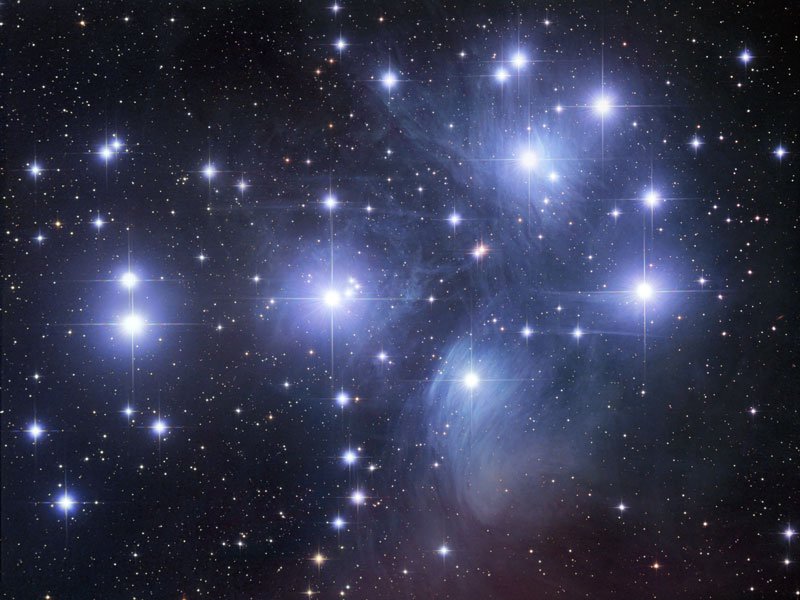

The appearance and behavior of this constellation are also a perfect fit to the story of the building of Asgard's wall.
On the first
day of summer, Mjöllnir (the Pleiades) rises over the horizon, as if to
smash the giant-builder (i.e. as he is setting). The giant started his
work at the first day of winter just after the Pleiades set (described
as Thor travelling to the east to slay trolls). That the Pleiades
indicate the starting point of the building of Asgard means, however,
that we have not only the exact timing at hand but can also locate the
walls of Asgard in the sky!
The walls
were built up near the gate of the stronghold at a time just before the
Pleiades and Taurus are rising. This must be a reference to the ancient
“Silver Gate of Man”. This is an ancient designation for the nexus of
the Milky Way and the ecliptic between Gemini and Taurus. In other
words, the wall the giant is erecting is the arch of the Milky Way!
After the setting of the Pleiades the Milky Way has indeed reached its
lowest position in the sky, and reaches its highest one at
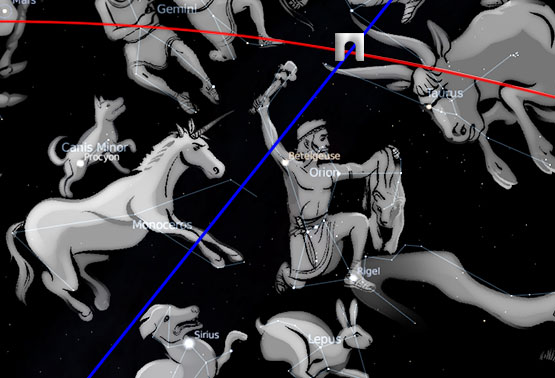
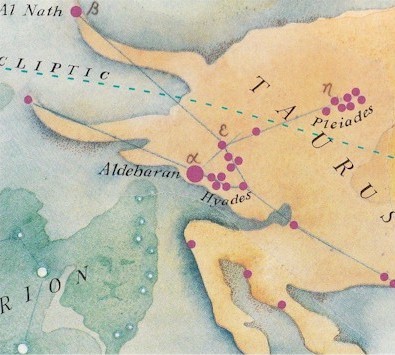
Is it also possible to locate the giant-builder?
If the walls had to be finished by building the gate at one nexus of the Milky Way with the ecliptic surely the gate at the other side of the Milky Way was also known. This nexus, the “Golden Gate of the Gods”, is located between Sagittarius and Scorpius. I assume this gate is identical to the Gjallarbru with the guard Modgud (Antares) in the myth concerning Hermóðr's ride to Hel (Gylfaginning 50).
As the giant-builder seems to be inside the walls, I assume he is identical to Sagittarius, a constellation that I previously have identified with the giant Hrymr in Völuspa and Hrungnir in Skáldskaparmál. The parallels between the myth of the deaths of Hrungnir and the giant-builder, beneath Mjöllnir are striking.
In Gylfaginning, the giant-builder constructs the wall with “grjot”. In Skaldskaparmál, Hrungnir stands on Grjóttunagard before his defeat. In Völuspá 52, we find the word Grótbjörg
|
Surtr ferr
sunnan |
52.
Surt fares from the south
with the bane of branches. the Val-god’s (or Valgods') sun shines from the sword; The stony hills gnash, gifur totter; men tread the Hel-way, and heaven is cloven. |
It’s
interesting to note that grjót not only means 'stones', but
that the low German word grott corresponds to gravel. This
might be further evidence that all of these words refer to the same
concepts (to the wall and to the Milky Way).
The giant
erects the walls with the help of his stallion. I assume this stallion
is a parallel to the famous Greek horse Pegasus that is depicted as a
constellation in the sky. It rises some time after Sagittarius, that’s
the reason he did not have its help from the beginning. During the last
phase of building up the walls, just before the rising of the Pleiades
the stallion was distracted by the appearance of a mare. I assume this
refers to the constellation Aries rising latest before the Pleiades. I
will shown in other investigations that Aries corresponds to
Gullinborsti, the golden boar of Freyr
and to Gullfaxi, the stallion of Hrungnir. Here, however, it seems to be
connected to Loki in the form of a mare.
